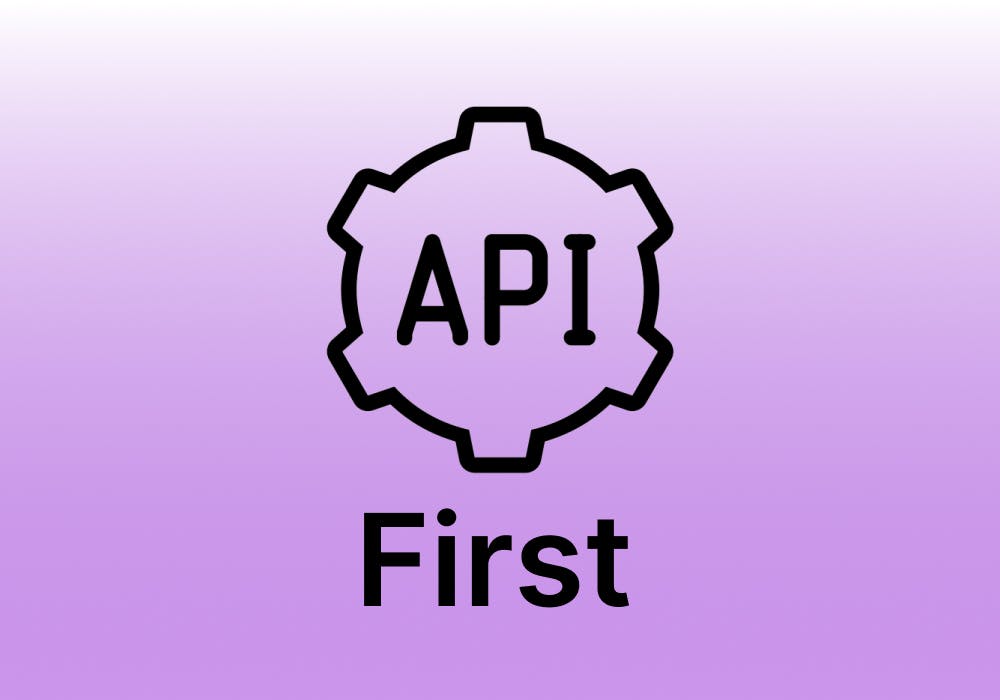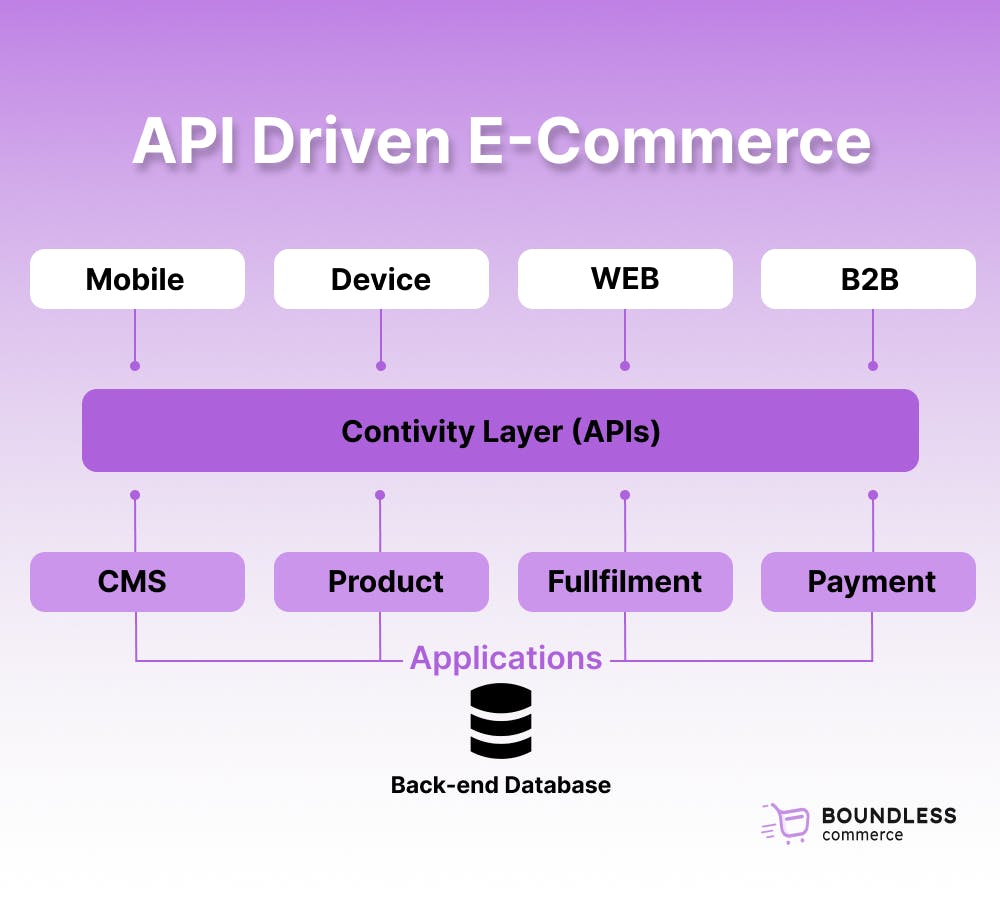API First eCommerce: A Game-Changer for Your Business
As the world of technology continues to evolve, so too does the way businesses sell their products and services online. One trend that has been gaining traction in recent years is API first ecommerce, a revolutionary approach that allows companies to better leverage the power of APIs in order to streamline and optimize their e-commerce operations.
In 2020, B2B e-commerce sales have reached $1 trillion and API traffic still growing at an unprecedented rate, it's clear that API-first e-commerce is a game-changer for businesses looking to take their e-commerce efforts to the next level.
In this blog post, we'll explore what is API first e-commerce, the benefits it can provide for your business, and steps you can take to get started on the path to revolutionizing the way you do ecommerce. So, get ready!
What is API-First?

API-first is a method of software development that prioritizes the creation of the API (Application Programming Interface) above all. The approach differs from traditional methods where the focus is on building applications or searching for backend systems of record. Instead, the API is considered the core component and is developed first.
Think of the API as a connector between internal systems and external parties. It provides a secure and structured way to expose the functionality of a company's systems to others.
The method is often referred to as API-first design and it's a crucial strategic move for businesses. By taking this approach, companies can view their operations in terms of capabilities and products, which can be imagined as a set of API products working together to access and secure data.
But that is not all, by making the API a core component of the development process, businesses can ensure that it is built to be robust, scalable, and easy to integrate with. It ultimately leads to a better customer experience and increased efficiency.
What is API-First E-commerce?
API-first ecommerce refers to an approach for building and running an online store where the API is the primary means of integration and communication between different systems and services. This is in contrast to traditional e-commerce platforms, which are typically monolithic and bundled with a front-end storefront, back-end management tools, and various other features.
As these are powerful tools that allow different software programs to communicate with each other without the need for direct integration. This means that programs can operate independently while still sharing data as needed, giving you the flexibility to create an eCommerce ecosystem that can work seamlessly together without relying on one another.
For instance, let's say you prefer using a specific Content Management System (CMS) but you want to keep your customer information in a separate Customer Relationship Management (CRM) program. An API can facilitate data sharing between these two systems while still allowing them to function independently.
In the context of e-commerce, "API-first" refers to building your online store's operations by utilizing these tools as a core component of your technology stack. Instead of being an afterthought, APIs are a key consideration when designing and building your eCommerce system, allowing you to optimize the full potential of these tools and create a more efficient and integrated experience for your customers.
Why Should You Care?
Flexibility and customization are key components of API-first e-commerce. It involves combining the greatest features of several front-end and back-end elements to produce a one-of-a-kind and customized shopping experience.
This method is especially helpful for companies developing an omnichannel or multichannel strategy. Your online business may easily be integrated with additional channels like mobile apps, social media, or physical retail locations when you use an API-first platform.
E-commerce that prioritizes APIs is also scalable. You can simply add or delete features or services without compromising the overall stability of your online store because the API serves as a bridge between various platforms. Because you don't have to rebuild or reconfigure your entire platform every time you want to make a change, you may save time and resources.
On the market, there are numerous API-first ecommerce platforms, each with a unique set of features and functionalities. Boundless Commerce, Salesforce Commerce Cloud, BigCommerce, and Elastic Path are a few of the more intriguing possibilities. A variety of tools and services are available on these platforms for creating, running, and expanding an online store that is powered by APIs.
The Core Benefits of an API-Driven Approach to E-Commerce
Implementing an API-first approach in e-commerce can yield significant benefits. Some of the core benefits might include:
Greater Control and Ownership
With an API first platform, you have greater control over the different components of your online store. You can choose the frontend framework or CMS that best suits your needs, and you can integrate with a variety of back-end systems and services. This can give you more ownership over your online store, as you are not tied to a specific vendor or platform.
Improved Security and Compliance
Also, it help you ensure better security and compliance for your online store. Because the API acts as a secure and standardized interface between different systems, you can more easily manage access and permissions, as well as enforce security protocols such as encryption or authentication.
Enhanced Customer Experience
By leveraging the flexibility and customization of an API first platform, you can create a more personalized and seamless shopping experience for your customers. For example, you could use APIs to integrate with customer data and preference systems or to provide real-time personalized recommendations or offers.
Reduces the Risk of Failure
API first ecommerce approach can mitigate the risk of failure by offering a consistent and clear structure for integrating different systems and tools. By exposing the e-commerce platform's functionalities through APIs, it enables a smoother integration and replacement of systems without negatively impacting the overall functioning of the platform.
This allows teams to make changes and updates more efficiently and effectively, reducing the likelihood of failure.
How to Get Started with API-First E-Commerce in 3 Simple Steps
Step 1: Choose the Right Platform and Tools
When planning to create an ecommerce store that prioritizes an API, it's essential to pick the perfect platform and tools that align with your business needs. Factors such as budget constraints, technical expertise, and desired outcomes should all be taken into account. When looking for an API-first platform, pay attention to key features: like ease of use, scalability, security, analytics, monitoring, the flexibility of use, integrations, development, testing, support and performance.
There are various important variables to take into account while selecting an API-first platform. To begin with, usability is essential. Developers will be able to rapidly and simply create and manage their APIs on a platform that is simple to use and intuitive. Time will be saved, and output will rise.
The platform should be able to manage a huge volume of API requests and readily scale to meet the needs of your expanding user base. Scalability is also crucial. In order to protect your data and guarantee that only authorized users can use your APIs, the platform should include strong security features like user authentication and access control.
Step 2: Build and Test Your API-Driven Storefront
Once you have selected your API-first platform, the next step is to build and test your storefront. This will typically involve designing and developing the user interface and user experience of your online store, as well as integrating with any necessary back-end systems or services.
There are various tools and frameworks available to help you with this process, such as headless CMSs, front-end libraries, or serverless functions. It is important to test your storefront thoroughly to ensure that it is functioning properly and providing a good experience for your customers.
Step 3: Integrate with Back-End Systems and Third-Party Services
To fully leverage the capabilities of an API-first e-commerce platform, you will need to integrate with various back-end systems and third-party services. This could include things like payment gateways, shipping and fulfillment systems, or marketing and analytics tools.
By using APIs to integrate these different systems, you can create a more seamless and efficient online store.
API-first eCommerce best practices
Design a Scalable and Flexible API Strategy
To maximize the potential of an API-first e-commerce platform, crafting a well-rounded, adaptable API strategy is crucial. This strategy should encompass determining specific business goals, recognizing vital systems and services that need integration, and formulating a plan for utilizing APIs to attain those objectives. Some tips for designing an effective API strategy include:
- Clearly define the purpose and goals of the API. This will help guide the design process and ensure that the API meets the needs of its intended users.
- Choose an appropriate architecture and protocol. RESTful architecture and HTTP/HTTPS protocol are widely adopted and are suitable for most use cases.
- Design a consistent, intuitive, and easy-to-use interface. This includes using clear and descriptive endpoint and parameter names, as well as providing detailed documentation and examples of how to use the API.
- Use standard HTTP response codes and error messages to indicate the status of requests and provide useful information to developers.
- Provide multiple formats for data exchange like JSON and XML
- Employ robust security measures, such as OAuth or JWT authentication and SSL/TLS encryption.
- Use versioning to manage changes to the API and avoid breaking existing integrations.
- Monitor, test and troubleshoot the API regularly, to ensure optimal performance and availability.
- Engage with developers and gather feedback to continuously improve the API.
- Plan for scalability in the design and infrastructure, especially when the API is expected to handle a lot of traffic.
- Consider how the API fits into the larger ecosystem of your company’s products and services, and align it with the overall business strategy.
Ensuring Security and Compliance
To keep your API-first ecommerce store running like a well-oiled machine (just putting humor in the middle of a serious discussion), you'll want to make sure you're meeting all the necessary security and compliance requirements.
This can include things like implementing strong authentication and authorization measures (so you can keep the bad guys out), using encrypted connections (so your customers' data stays safe and sound), or following industry-specific regulations (so you don't get in hot water).
But don't worry, it's not all doom and gloom, following best practices like these will ensure that your store runs smoothly and you can sleep soundly at night.
- Use robust authentication and authorization methods, such as OAuth or JWT, to ensure that only authorized users can access the API.
- Implement SSL/TLS encryption to protect sensitive data, such as credit card information, from being intercepted or stolen during transmission.
- Regularly update and patch your systems and dependencies, to protect against known vulnerabilities.
- Monitor the API for unusual or suspicious activity, and have an appropriate response and incident management plan in place.
- Use token-based rate limiting to prevent DDoS attacks and protect against brute force attacks.
- Consider implementing a Web Application Firewall(WAF) to protect against common API-specific attacks, such as SQL injection and cross-site scripting (XSS).
- Follow industry-standard compliance regulations, such as PCI DSS for credit card data, and HIPAA for personal health information, to ensure that you are handling sensitive data securely and appropriately.
- Have a detailed security and compliance strategy in place, that is regularly reviewed and updated, and make sure that your team is trained on it.
- Use third-party security solutions like vulnerability scanners, and penetration testing to identify and remediate any security issues.
- Have a disaster recovery plan in place, to ensure that you can quickly recover from a security incident or data breach.
- Implement logging and auditing to keep track of user activities and detect any suspicious patterns.
Monitoring and Optimizing API Performance
Finally, it is critical to monitor and optimize the performance of your APIs to ensure that your API-first e-commerce store runs smoothly and efficiently. It may entail tracking API usage with tools, identifying bottlenecks or errors, and implementing fixes or improvements. The following are some best practices for monitoring and optimizing API performance:
To ensure that your API runs like a boss, you must first understand how it should perform and then set specific targets and benchmarks for things like response times and error rates.
You should also use real-time monitoring and alerting tools to monitor API performance and quickly identify and resolve any issues that arise.
You can gather data on usage patterns and traffic by using logging and analytics, which can help you understand how the API is being used and identify areas for optimization.
Regularly test and stress-test the API to ensure that it can handle expected and unexpected traffic spikes and loads. Optimize the database queries and caching of the API to ensure quick and efficient data retrieval.
Utilize caching techniques to limit the number of API queries made and the server's workload. Use edge computing and content delivery networks (CDN) to make the API more responsive and reduce latency for users in various regions.
Make sure the underlying infrastructure is correctly configured and scaled to manage the anticipated traffic while keeping an eye on how much of the API's resources are being used. To swiftly find and resolve any problems, use error tracking and debugging tools.
Review and improve the codebase on an ongoing basis to simplify it and boost performance. Engage developers and collect feedback to progressively enhance the performance of the API. And, have a disaster recovery plan beforehand to make sure you can quickly recover from a performance incident, anytime, anywhere.
Real World Examples of API-First E-Commerce Platforms

API-driven ecommerce has been adopted by industry leaders such as: API-first e-commerce strategies have been successfully implemented by several industry leaders. Boundless Commerce, Amazon, Stripe, Shopify, Square, and BigCommerce are a few examples.
Let’s break it down with our platform Boundless Commerce. Boundless Commerce includes an admin panel for store management, a robust API, and a ready-to-use checkout area. There's no need to be concerned about the backend or how your content will appear on different devices with its headless CMS. Also, it provides you with a bit more control and flexibility over how your content appears on the frontend.
And, rest of those popular platforms that we’ve have mentioned above come with a set of APIs that give you the power to access a various products and services, from product search and customer reviews to shopping cart management.
Moreover, Stripe's API allows easy payment acceptance, subscription management and financial transactions. On the other hand, Shopify, Square, BigCommerce and Magento's APIs let businesses create custom eCommerce experiences.
These platforms offer the tools and flexibility to make your online store stand out and keep your customers happy.
Bringing It Home - API First eCommerce
In the future, e-commerce businesses will be using lots of small microservices to make their stores more flexible and scalable. They'll also be using a headless e-commerce which allows for more customization. And, most importantly, they'll be extra careful with security to protect customer data.
This way, businesses can quickly adapt to changing customer needs, try new things and easily connect with other systems and services. Basically, if you adopt these strategies, you'll be a step ahead of the competition in the e-commerce game.
In short, the future of e-commerce is all about being nimble, creative and secure. And who doesn't want that, right?
Thanks a lot for reading the whole blog post. Best wishes!

